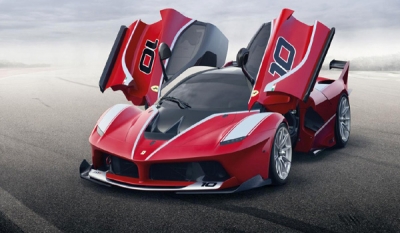Formerly known as the LaFerrari XX, the car is based on the LaFerrari, the company’s first hybrid machine, and will be launched next year.
The K in its moniker is a reference to the KERS kinetic energy recovery system it adopts. The FXX K will never be used in competition and has been developed to be “completely uncompromising, incorporating technological innovations”.
It will be offered to an exclusive group of clients with whom the company will roll out a test program over the coming two years.
As rumored before, the FXX K unleashes a maximum output of 1050 PS (772 kW) thanks to an 860 PS (633 kW) V12 engine and a 190 PS (140 kW) electric motor. The maximum torque is more than 900 Nm (664 lb-ft).
The 6.2-liter V12 of the machine features new camshafts and a modified valve train with mechanical rather than hydraulic tappets. The intake manifolds have been redesigned and given a special type of polishing treatment. The exhaust system has been also modified as its silencers have been eliminated.
The optimized HY-KERS system has a control unit from which the driver can select from four different modes. The Qualify mode gives maximum performance within a limited number of laps, the Long Run mode optimizes "performance consistency", the Manual Boost mode provides instant maximum torque delivery and the Fast Charge mode is suitable for a faster recharge of the car’s battery.
In terms of design, the front of the car is dominated by a twin-profile spoiler and a larger splitter, which is 30 mm lower than the standard one.
Two pairs of vertical elements, an endplate and a dive plane, together with vertical fins channel the air towards the car’s flanks, generating “a longitudinal vortex that creates a localized depression”. On the side profile we see new side skirts, while at the back the tail section is now higher and features a mobile spoiler with a small wing on each side.
Ferrari says the result is a 50% improvement in down force in the low drag configuration and a 30% improvement in the more aggressive down force configuration, resulting in a figure of 540 kg (1,190 lbs) at 200 km/h (124 mph), more than double the road car’s 230 kg (507 lbs).
The Italian company has also equipped the track-focused beast with Pirelli slicks complete with sensors that monitor longitudinal, lateral and radial acceleration, as well as temperature and pressure.
A five-position Manettino button on the steering wheels serves as a control unit for the intervention level of the E-Diff electronic differential, the F1-Trac traction control, the Racing SSC (Side Slip Angle Control) system and the high-performance ABS.
Prices and production numbers haven't been announced.























